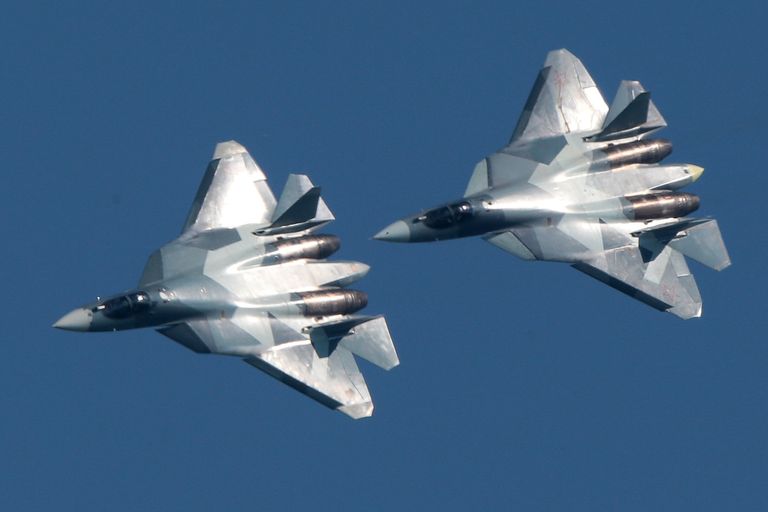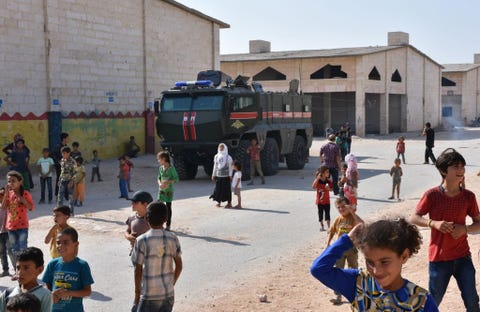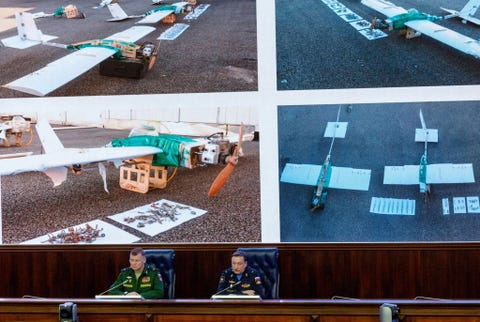Russia Just Sent Its Best Fighter Plane to Syria
The Su-57 could soon encounter its rival, the F-22 Raptor, over the Middle East.
By Kyle Mizokami

GETTY IMAGESSERGEI BOBYLEV
Moscow sent two of its most advanced fighter jets to Syria yesterday. The Su-57s flew into Khmeimim air base yesterday, representing a major escalation of Russian air power in the region. The deployment is a chance to test the jet in real-world conditions, but Russia risks losing the aircraft to guerrilla warfare—particularly drone attacks.
Last night, video circulating on social media purported to show two Su-57 jets landing at Khmeimim, Russian’s main air base in Syria. It's good to be skeptical of such rumors at first, since a lot of fake military news circulates on social media, such as China deploying its only aircraft carrier to Syria and American destroyers in the Black Sea suffering EMP-like blackouts due to Russia wonder weapons.
Early video of the Su-57 incident was shaky and abrupt, and nobody expected the Russians to send the Su-57 to Syria. Still, as more sightings, video and confirmation piled up it became clear the deployment was real.
The jet is Russia’s first so-called fifth generation fighter, putting it in the same class as the F-22 Raptor and F-35 Joint Strike Fighter. Fifth-gen fighters typically combine stealth, large, powerful engines that allow them to cruise above the speed of sound, networking capability, and advanced avionics and radar.
The Su-57 first flew in 2010, and has experienced considerable trouble during its development period. Things got so bad that the Indian Air Force, a frequent buyer of Russian military hardware and partner in the program, wants to bail on the project. Even now, eight years later, only ten prototypes are believed to be in operation. The two Su-57s that just landed in Syria are probably two of those prototypes.

New Russian Typhoon MRAP operating in Syria.
GETTY IMAGESGEORGE OURFALIAN
Why was the Su-57 sent to Syria, a war fought without air-to-air combat? Russia has used Syria as a sort of proving ground for its latest equipment, including the T-90 tank, Pantsir mobile air defense system, and Typhoon mine resistant armored protection vehicles. The Russian Air Force will learn a lot about how the jet works in less-than-ideal conditions, how good its sensors are at picking up targets in the air and on the ground, and how difficult it is to maintain the planes thousands of miles from Mother Russia.
Another reason the Su-57 went to Syria? The F-22. The U.S. Air Force has operated the Raptor over Syria for months in a "deconfliction" role. It is quietly identifying Russian aircraft and surface-to-air missile systems, and almost certainly watching over U.S. and anti-ISIS coalition aircraft. Russia may also want Su-57s over Syria so too it can claim it has fifth-generation fighters over Syria.
American Raptors have proved decisive in at least one encounter: in late 2017, a F-22 Raptor launched anti-missile chaff and flares near two Russian Su-25 ground attack jets that had intruded on American-controlled airspace. The Russian Air Force scrambled a Su-35 fighter in response. The Su-35, a modernized version of the 1980s-era Su-27 Flanker, is a highly effective aircraft but lacks stealth and is not a fifth generation fighter. Raptors and Su-57s could soon fly the same airspace and be involved in the same incidents.

Russian Defense Ministry press conference displaying suicide drones recovered after the January 2018 attack.
GETTY IMAGESVADIM SAVITSKY
The deployment of the Su-57 is not without risks. In December, an unknown group launched coordinated suicide drone attacks against Khmeimim and the Russian naval base at Tartus. Thirteen drones packed with explosives attacked the Russian bases, but all were shot down or brought down by base defenses. Just a month ago, a rebel artillery attack destroyed four Su-24 strike aircraft, two Su-35 multi-role fighters, and a A-50U airborne early warning aircraft on the ground at Khmeimim. Losing one of the most advanced fighters in the world to a $1,000 mortar would be very embarrassing to the Moscow.
Despite the Su-57’s showing in Syria, don’t expect to see large numbers of the jets any time soon. Russia has placed orders for just twelve production aircraft, in part because of their high cost but also because a new engine developed for the aircraft, the Saturn izdeliye 30, is not ready. The dozen production aircraft, set to be delivered next year, will fly with older, less powerful Saturn AL-41F engines.
No comments:
Post a Comment